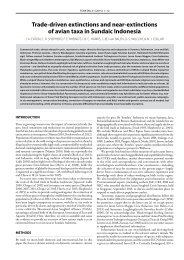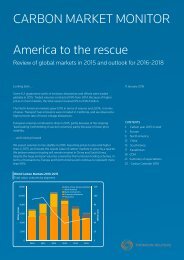Emissions Trading Worldwide
1TbjEHd
1TbjEHd
You also want an ePaper? Increase the reach of your titles
YUMPU automatically turns print PDFs into web optimized ePapers that Google loves.
Tianjin (Pilot) <strong>Emissions</strong> <strong>Trading</strong> System<br />
in force<br />
emissions coverage (Mtco 2 e, 2015)<br />
Liable entities<br />
160.0 112<br />
Gas coverage<br />
allocation<br />
Offsets & Credits<br />
co2 only<br />
free allocation<br />
domestic<br />
On 26 December 2013, Tianjin was the fifth Chinese region, after<br />
Shenzhen, Shanghai, Beijing and Guangdong, to start its pilot ETS.<br />
The system covers enterprises from five sectors: heat and electricity<br />
production, iron and steel, petrochemicals, chemicals, as well<br />
as oil and gas exploration. These industries account for around<br />
60% of the city’s total emissions. The second compliance period<br />
ended in July 2015.<br />
background information<br />
Overall Ghg <strong>Emissions</strong> (excl. LULUCF) 215 MtCO 2 e (2012)<br />
GHG Reduction Targets By 2015 (12 th Five Year Plan): 19% reduction in carbon<br />
intensity compared to 2010 levels.<br />
Flexibility<br />
Banking and borrowing Banking is allowed during the pilot phase.<br />
Borrowing is not allowed.<br />
Offsets and Credits Quantitative Limit: Domestic project-based carbon<br />
offset credits — China Certified Emission Reduction (CCER)— are allowed. The<br />
use of CCER credits is limited to 10% of the annual compliance obligation.<br />
Qualitative Limit: Credits have to stem from CO 2 reduction projects, excluding<br />
hydro and have to be realized after 2013.<br />
PRICE MANAGEMENT PROVISIONS In case of market fluctuations, the Tianjin<br />
Development and Reform Commission (DRC) can buy or sell allowances in<br />
order to stabilize the market.<br />
compliance<br />
ets size<br />
Cap 160 MtCO 2<br />
emissions coverage<br />
MRV Reporting Frequency: Annual reporting of CO 2 emissions. Verification:<br />
Third-party verification is required.<br />
Enforcement In case of non-compliance, companies are disqualified for preferential<br />
financial support and policies for three years. There are no financial<br />
penalties for non-compliance.<br />
covered<br />
60%<br />
not covered<br />
40 %<br />
other information<br />
GHG Covered CO 2<br />
Sectors & THRESHOLDS Heat and electricity production, iron and steel, petrochemicals,<br />
chemicals, exploration of oil and gas. Inclusion threshold:<br />
20,000t CO 2/year considering both direct and indirect emissions.<br />
Point of regulation Mixed: Both direct emissions from the power sector<br />
and indirect emissions from electricity (and heat) consumption are included in<br />
the scheme. Electricity prices are regulated in China, and therefore a scheme<br />
based on direct emissions alone would not induce a pass-through of carbon<br />
costs via the electricity price, and would not incentivize demand-side management<br />
of electricity. The system therefore covers emissions from the power sector<br />
upstream and other sectors downstream.<br />
Number of liable entities 112 (2014)<br />
Institutions involved Tianjin DRC (Competent authority), Tianjin Climate<br />
Exchange (<strong>Trading</strong> platform)<br />
Phases and Allocation<br />
<strong>Trading</strong> periods Three years (2013–2015) 1<br />
allocation Mainly free allocation through grandfathering based on<br />
2009– 2012 emissions or emissions intensity. Benchmarking for new entrants<br />
and expanded capacity.<br />
COMPLIANCE PERIOD One year (31 May)<br />
1 Initially, the seven Chinese pilot ETS were scheduled to end after three compliance years and be<br />
replaced by the national ETS in 2016. However, as the national ETS will not start before 2017, the pilots<br />
will likely be extended until then.<br />
international carbon action partnership<br />
65




